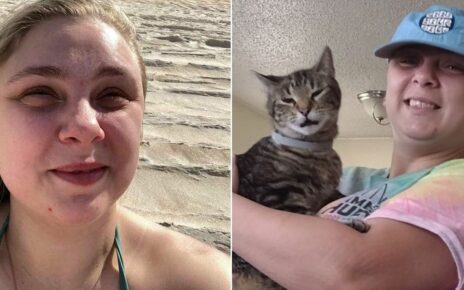WE all know the hallmark symptoms of anxiety.
From nervousness, to sweating to not being able to concentrate – chances are you've experienced them before.
But there's a lesser-known sign linked to a rare condition that bizarrely makes the world you see look like a snow globe.
Visual-snow syndrome is a rare neurological disorder that scientists first recognised in 1995.
Most people experiencing it by always seeing tiny, snow-like flecks in their vision, as if the world in front of them is a badly tuned old TV set or indeed, a snow globe.
The dots are usually black and white, though they can sometimes be colourful or transparent.
Read more non eye issues

I was so fat I went blind after secret McDonald's – I've lost 7st eating curry

I’m an expert – here’s the 6 ways your eyes can warn of dangerous health issues
The condition, which has no known cause, can be debilitating to some, affecting their ability to work and finish school, as it can make concentrating more difficult.
Some scientists believe the disorder affects part if the brain near the occipital lobe, responsible for sight and perception.
It's also previous been associated with anxiety.
A 2014 study of 125 people with visual snow syndrome were more likely to suffer from anxiety, depression, poor sleep quality, and fatigue.
Most read in Health

DIY gadget that zaps penis ‘works like Viagra – banishing erection problems’

From frustration with friends to being misunderstood – subtle signs of autism

Warning to millions taking common drugs over risk of catastrophic side effect

Forget long Covid! Long COLDS are a thing, scientists find – are you a victim?
US scientist also found stronger links in people with dissociative conditions like depersonalisation disorder, which the NHSsays leave sufferers feeling disconnected from yourself and the world around you.
Medics still don't know how to treat visual snow syndrome.
In some cases, anti-seizure medication and antidepressants have worked to reduce the symptoms.
Anxiety, on the other hand, can be treated.
The condition, which affects around 8million Brits, leads to feelings of unease, such as worry or fear, that can be mild or severe.
It's often the main symptom of other conditions, like agoraphobia or claustrophobia, panic disorders or post-traumatic stress disorder (PTSD).
Psychological therapy, such as cognitive behavioural therapy has been shown to be effective in some people.
While, medication – such as a type of antidepressant called selective serotonin reuptake inhibitors (SSRIs) – can also reduce symptoms.
Read More on The Sun

Kerry Katona shows off her 'lumps and bumps' in bikini as she hits out at trolls

Martin Lewis' message to all 'savvy mum savers' shopping for toys this Xmas
Other common symptoms of anxiety
According to the Mayo Clinic, typical anxiety signs and symptoms include:
- Feeling nervous, restless or tense
- Feeling as if something bad is about to happen
- Increased heart rate
- Breathing rapidly
- Sweating
- Trembling
- Feeling weak
- Trouble concentrating or thinking about anything other than the present worry
- Having trouble sleeping
- Experiencing gastro issues
- Having difficulty controlling worry
- Having the urge to avoid things that trigger anxiety
Source: Read Full Article



